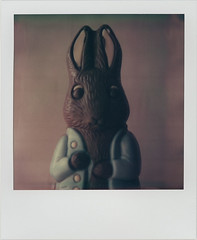| In the Ukraine, they make gorgeous eggs as part of their pagan heritage. |
Many of my readers know that Easter, as it is celebrated here in the US by most of the population, has pagan roots. All the familiar trappings of feasts, baby chicks and bunnies, and eggs as the theme have their home in European pagan/polytheist traditions.
Even the name, "Easter" is not Christian- it comes from the name of a goddess, Eostre (also called Ostara- which is the name of a spring witches' sabbat), whose name also is the root of the word "estrus" and "estrogen" as well as Easter. She is (you guessed it!) a fertility goddess of spring whose symbols include (oh so fertile!) rabbits and fertile eggs. Rabbits are also tied in here because they are the moon (most peoples see a hare, not a man, in the moon) and this goddess is a lunar goddess.
Recently, while discussing this holiday, I was told by a friend (who was raised Christian) that she was told as a child that Easter had dyed Easter eggs as part of the celebration because they remind us of "the rock that blocked the cave that Jesus was resurrected in". She was told people have egg rolling games on the lawn to remember rolling the rock from out of in front of the opening, unsealing it. I laughed, because which description sounds more plausible to you? Pretty far-fetched idea- but I suppose there has to be some non-pagan reasoning for Christians to enjoy a good egg hunt, games, and feast!
In Sweden, Easter is also quite pagan.
What do you do, if anything, for this holiday? This year, Rowan is taking part in a child dedication rite at our UU church.
As he gets older, we will be having a traditional feast of Eostre, with roast pig. We will dye and hide eggs, make seasonal crafts and altars, and eat chocolate rabbits.
| Behold the hare in the moon! |
Even the name, "Easter" is not Christian- it comes from the name of a goddess, Eostre (also called Ostara- which is the name of a spring witches' sabbat), whose name also is the root of the word "estrus" and "estrogen" as well as Easter. She is (you guessed it!) a fertility goddess of spring whose symbols include (oh so fertile!) rabbits and fertile eggs. Rabbits are also tied in here because they are the moon (most peoples see a hare, not a man, in the moon) and this goddess is a lunar goddess.
Recently, while discussing this holiday, I was told by a friend (who was raised Christian) that she was told as a child that Easter had dyed Easter eggs as part of the celebration because they remind us of "the rock that blocked the cave that Jesus was resurrected in". She was told people have egg rolling games on the lawn to remember rolling the rock from out of in front of the opening, unsealing it. I laughed, because which description sounds more plausible to you? Pretty far-fetched idea- but I suppose there has to be some non-pagan reasoning for Christians to enjoy a good egg hunt, games, and feast!
"Like all the church's 'moveable feasts', Easter shows its pagan origin in a dating systems based on the old lunar calendar. It is fixed as the first Sunday after the first full moon after the spring equinox, formerly the 'pregnant' phase of Eostre passing into the fertile season...." - The Women's Encyclopedia of Myths and SecretsOne curious 16th century Easter custom was known as "creeping to the cross with eggs and apples"- a significant use of birth and death imagery (eggs being the beginning and apples being the end- the fruition of life)- that reflects not Christian theology, but pagan ones- the opening and closing of cycles. The kings of England at this time demanded carpets be laid in the church for this ritual, because their knees were getting scuffed! I find it interesting that kings were required to do this, in the guise of something remotely Christian. These kings were only ceremonial and very much like the sacred kings of old, except that they got to live as king for more than a year!
 Image by futurowoman via Flickr Image by futurowoman via Flickr |
| I will advise Rowan to eat the ears first. |
What do you do, if anything, for this holiday? This year, Rowan is taking part in a child dedication rite at our UU church.
As he gets older, we will be having a traditional feast of Eostre, with roast pig. We will dye and hide eggs, make seasonal crafts and altars, and eat chocolate rabbits.




We celebrated Ostara on the equinox in march. We hid a basket of goodies which we told our daughter was brought by Eostre's rabbit. We decorated our giant ficus tree with colorful ribbons and plastic eggs, we colored eggs and did an egg divination. Today we will have dinner with our family and do an egg hunt (weather permitting).
ReplyDelete